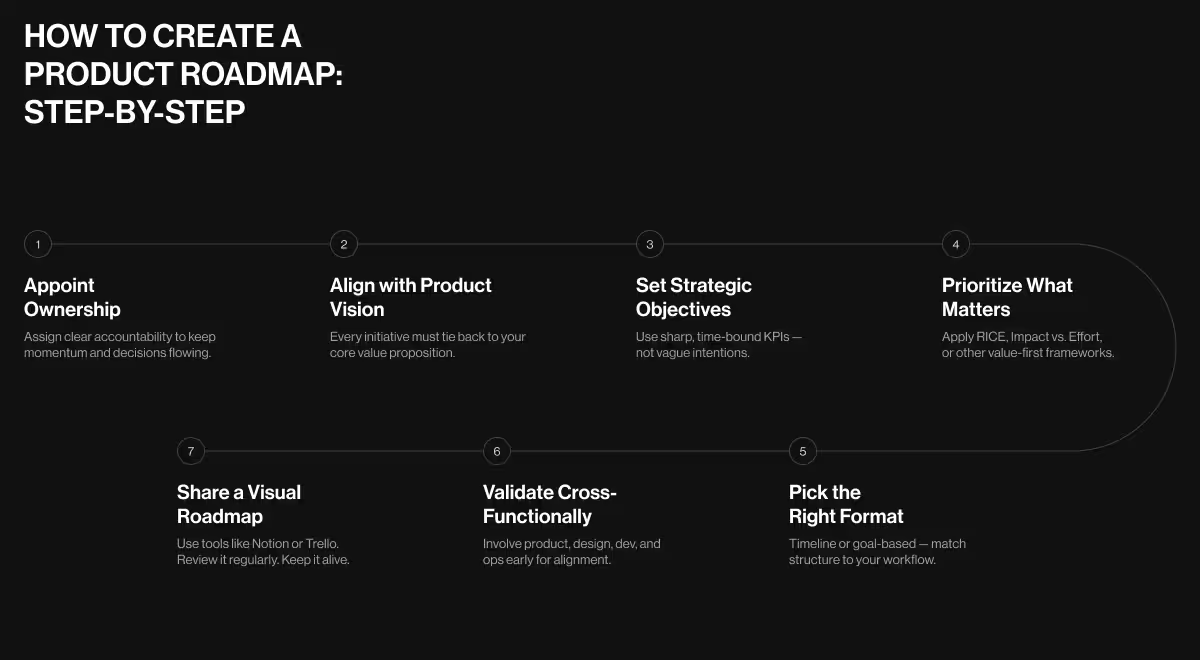Reviewed by: Lazarev.agency Product & UX Strategy Team
Last updated: November 2025
Relevant work: VTnews.ai roadmap, Teachchain platform strategy, SaaS and AI product roadmapping for startups and enterprises
A high-performing product roadmap starts with clear, measurable outcomes and a sharp product vision, then maps initiatives, formats, and timelines backward from those goals. The most successful teams treat the roadmap as a living, visual decision tool aligned with strategy, validated cross-functionally, and regularly updated.
Key takeaways
- Outcome-first wins. Define measurable business and product outcomes, then reverse-engineer initiatives.
- Know your concepts. Separate product vision, strategy, roadmap, and plans so you don’t confuse storytelling with execution.
- Choose the right format. Timeline, goal-based, agile, portfolio, or hybrid — pick what fits your maturity and planning rhythm.
- Avoid common pitfalls. No vision alignment, overly rigid plans, too much detail too early, missing stakeholders, ignoring scalability and AI.
- Make it visual and shared. Use collaborative tools, regular reviews, and visible ownership so the roadmap guides daily decisions.
When Netflix transitioned from DVD rentals to streaming, it had more than a clear vision in its arsenal. It took the market by storm with a smart product roadmap that aligned cross-functional teams and guided the company through shifting technology and user expectations.
Many companies are far less deliberate. They launch products with strong teams and promising ideas, but without a roadmap, direction falters and focus drifts. Vision alone is not enough.
Effective roadmaps operationalize vision, make sense of feature requests, and ensure business outcomes aren’t left to chance.
In this article, we share expert insights on developing a product strategy roadmap that supports decision-making across teams and guides sustainable and scalable business growth.
What’s the difference between product vision, strategy, roadmap, and plan?
Teams tend to use terms like product strategy, product vision, roadmap, and plan interchangeably. While these concepts operate within the same business ecosystem, each serves a distinct purpose.
The table below breaks down commonly confused product planning concepts. Use it to align your product and development teams around what each element means and why each matters for business success.
📌 Use this as your internal cheat sheet:
Vision → Strategy → Roadmap → Plans → Backlog → Execution.
Each layer answers a different question and should never be collapsed into one slide.
👉 See how great products start with clarity in our research and strategy guide.
How to create a product roadmap step-by-step
Now that we’ve separated the concepts, let’s move into action: how to build a roadmap that your team actually uses.

Step 1: Appoint clear ownership
Define who owns the roadmap.
Ownership means:
- accountability for the roadmap’s quality
- responsibility for cross-functional input and coordination
- making sure the roadmap reflects both strategy and reality
Without a clear owner, roadmaps turn into group projects nobody quite controls.
Step 2: Align the product roadmap with product vision
Every significant initiative should trace back to the product vision.
Start with:
- Where does the product need to go?
- What problems should it solve best?
- What value should it uniquely deliver?
Then work backward.
“A strong product vision filters out the noise. When we worked on the VTnews.ai product roadmap, we used the core value proposition — real-time, AI-powered news curation — as our benchmark. Any initiative that didn’t reinforce speed, personalization, or content credibility was deprioritized. If a feature doesn’t serve your product’s ‘why’, it doesn’t belong on the roadmap.”
{{Ostap Oshurko}}
Step 3: Set sharp, measurable strategic objectives
A roadmap without measurable objectives is just a decorated to-do list.
Use time-bound KPIs and be painfully specific:
“Turn broad intentions into sharp targets. Avoid vague ‘We want to improve retention rates’. Instead, formulate objectives clearly. For example: ‘Increase monthly customer retention from 70% to 85% by December 31, 2025’. This way, you set a clear baseline, a specific goal, and a deadline, providing your team with a tangible outcome to work toward.”
{{Oleksandr Koshytskyi}}
Anchor your roadmap to outcomes like:
- retention
- activation
- NPS
- expansion revenue
- time-to-value
Then assess whether each initiative meaningfully pushes one of those.
👉 Set sharper objectives by grounding your KPIs in real industry data. Check out an example of B2B SaaS benchmarks.
Step 4: Prioritize what delivers real value
Not every good idea makes the roadmap.
Use frameworks to bring structure to prioritization conversations:
- RICE (Reach, Impact, Confidence, Effort)
Great for data-driven decisions where you have solid inputs and need comparability. - Impact vs. Effort
Perfect for workshop environments, aligning stakeholders quickly on low-hanging fruit vs. strategic bets.
Mix methods if needed. The point is not to worship a framework. It’s to make trade-offs visible and defensible.
Step 5: Choose the right roadmap format for your team
The wrong roadmap format creates confusion. The right one amplifies clarity and focus.
Ask:
- How often do we re-plan? (quarterly, monthly, “continuously”?)
- Who needs to read this? Execs only, or the entire organization?
- How volatile is our market and product direction?
✅ Pro tip: Match your roadmap format to your decision-making cadence. If you plan quarterly, a timeline-based roadmap works well. If priorities shift frequently, a goal-based or theme-based roadmap will break less often.
(We’ll break down roadmap types in the next section.)
Step 6: Validate the roadmap with cross-functional teams
A roadmap built in isolation rarely survives its first quarter.
Bring in:
- engineering and data
- design and research
- marketing, sales, and success
- operations and, where relevant, compliance or security
“The roadmap only works when everyone sees themselves in it. When working on Blockbeat’s website, it was early input from internal teams that helped us catch blind spots and commit with confidence.”
{{Oleksandr Koshytskyi}}
This is where you surface:
- dependencies
- capacity issues
- risk around timing and scope
- misaligned expectations
Better to find out in a workshop than mid-sprint.
Step 7: Build and share a visual strategic roadmap
Turn the roadmap into a visual, collaborative artifact, not a static PDF.
Tools like Aha!, Notion, ClickUp, Trello, or Jira Advanced Roadmaps work well when:
- everyone knows where the roadmap lives
- it’s easy to update
- it’s reviewed on a predictable cadence
✅ Pro tip: Schedule monthly or quarterly roadmap reviews. Use them to:
- incorporate customer insights and analytics
- respond to market or pricing changes
- re-balance based on team capacity
- reprioritize initiatives based on new data
Static roadmaps erode trust. Living ones build it.
Types of product roadmaps and when to use each
You’ve now laid the strategic groundwork and defined priorities that align your team around a clear direction. Yet, selecting the right kind of roadmap is just as important as building one. Different teams and products thrive on different roadmap formats. What works for a scaling SaaS product might not suit a launch of an MVP product.
Let’s explore the main product roadmap examples and when to use each one to drive measurable impact.
✅ Pro tip: You don't have to create your product roadmap from scratch. Look for relevant templates on platforms like ClickUp or Monday to find one that matches your product vision.
6 common product vision & roadmapping pitfalls and how to avoid them
Choosing a fitting product strategy roadmap is just the start. Avoid these common pitfalls to maintain an aligned and highly adaptable product vision throughout the development process.
Why build a product roadmap at all?
A product roadmap is your strategy in motion. It defines the key steps that turn vision into reality and connects:
- goals
- releases
- core features
- technical foundations
“A well-structured visual product roadmap turns strategy into an actionable plan by connecting high-level goals with day-to-day execution. A structured approach was a key success driver in refining brand identity for Teachchain. We built a visual roadmap that mapped how contributors drive platform value, shaping early UX around content creation, approval flows, and marketplace visibility. This clarity helped prioritize gamified progress tracking for students, while the brand identity was crafted to reflect Teachchain’s mission: turning IT education into a global, peer-powered movement.”
{{Ostap Oshurko}}
A strong product vision roadmap helps you:
- distill and communicate product vision and strategy
- keep cross-functional teams and stakeholders aligned on progress
- focus on initiatives with the greatest business impact
- track progress from concept to release
- integrate scalable initiatives such as AI-powered capabilities
✅ Pro tip: Start with outcomes. Decide what success looks like (e.g., activation +15%, churn -5%, ARR +20%), then reverse-engineer initiatives and releases that make those outcomes realistic.
Quick checklist: is your roadmap doing its job?
Use this as a quick health check:
- Tied to quarterly or annual business goals
- Visible and understandable across leadership and internal teams
- Prioritized based on customer insights and value, not opinions alone
- Accounts for technical debt, scalability, and risk
- Reviewed and updated regularly (monthly or quarterly)
- Incorporates AI and analytics to inform decisions, not just intuition
If you can’t tick most of these boxes, your roadmap is likely a document, not a strategy tool.
Turn your vision into an actionable roadmap with Lazarev.agency
In an agile, AI-driven world, roadmaps are no longer “fixed five-year plans.” They’re shorter-horizon, living documents that:
- respond to changing priorities
- align teams faster
- and keep execution grounded in real outcomes
What hasn’t changed is the requirement that they work.
Lazarev.agency, an expert at UI/UX design for AI/ML products, helps teams:
- clarify product vision and strategy
- design visual, outcome-driven roadmaps
- integrate AI into both the product and the planning process
- bridge the gap between leadership intention and delivery reality
If you’re ready to turn your roadmap into a growth driver instead of a slide deck:
👉 Explore our UX case studies first
👉 And then contact Lazarev.agency for a roadmap engagement that aligns your vision with execution and accelerates product growth




























.webp)




















